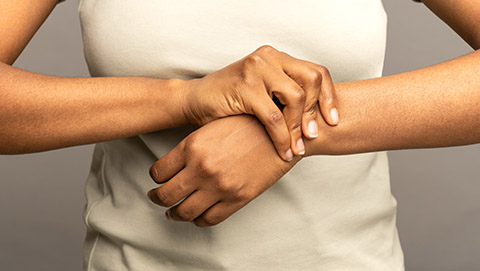
A client is sore and has joint pain in multiple locations. She is easily triggered into painful spasms. And . . . she has an unusual form of spina bifida.
What is spina bifida? What makes this person’s experience of it unique? And what opportunities are here for massage therapy to be helpful?
Resources: 
Pocket Pathology: /abmp-pocket-pathology-app
CDC (2020) What is Spina Bifida? | CDC, Centers for Disease Control and Prevention. Available at: https://www.cdc.gov/ncbddd/spinabifida/facts.html (Accessed: 8 August 2022).
Sencen, L. (no date) ‘Spina Bifida’, NORD (National Organization for Rare Disorders). Available at: https://rarediseases.org/rare-diseases/spina-bifida/ (Accessed: 8 August 2022).
Spina Bifida Causes, Treatment, Symptoms, Types & Life Expectancy (no date) eMedicineHealth. Available at: https://www.emedicinehealth.com/spina_bifida/article_em.htm (Accessed: 8 August 2022).
Tethered Spinal Cord Syndrome | National Institute of Neurological Disorders and Stroke (no date). Available at: https://www.ninds.nih.gov/health-information/disorders/tethered-spinal-cord-syndrome (Accessed: 8 August 2022).
Podcast on Chiari Malformation:
/podcasts/ep-208-chiari-malformation-i-have-client-who-pathology-conversations-ruth-werner


Books of Discovery:www.booksofdiscovery.com
Advanced-Trainings: www.advanced-trainings.com
About Til Luchau and Advanced-Trainings.com:
As a Certified Advanced Rolfer™, Til was on the faculty of the Dr. Ida Rolf Institute® for 20 years, where he served as Coordinator and Faculty Chair of the Foundations of Rolfing Structural Integration program. The author of the Advanced Myofascial Techniques textbook series (which has been translated into 6 languages), his regular Myofascial Techniques and Somatic Edge columns have been featured in Massage & Bodywork magazine since 2009, and (along with Whitney Lowe) he co-hosts the popular Thinking Practitioner Podcast. He is the Director of Advanced-Trainings.com, which since 1985 has offered short, credit-approved professional trainings and certification for manual therapists of all types, in person and online.
Website: Advanced-Trainings.com
Email: info@advanced-trainings.com
Facebook: facebook.com/Advanced.Trainings1/
Instagram: instagram.com/tilluchau
YouTube: youtube.com/user/AdvancedTrainings
0:00:00.1 Speaker 1: Til Luchau is pleased to invite you to two amazing opportunities. Come to Til's popular hands-on sciatica training as it makes its Zoom debut on August 12. Get a full day of personalized tutoring, camera on supervision and permanent recordings and CE credit all at an amazing price. Til's new A-T Subscription gives unlimited access to a growing catalog of over 35 curated advanced myofascial techniques, Feldenkrais and Zoga movement classes for body workers for as little as $20 per month. Sign up now at advancedtrainings.com.
0:00:48.0 Ruth Werner: Hey, I Have a Client Who listeners, did you know I have a growing library of NCB-approved one-hour online self-paced continuing education courses that you can do any time, anywhere? Well, now you know. Current classes include what's next COVID-19 updates for massage therapists and A Massage Therapist's Introduction to Pharmacology part one, and brand new, A Massage Therapist's Introduction to Pharmacology part two. Classes are $20 each and they confer one hour of continuing education credit. Wanna know more? Visit my website at ruthwerner.com and check it out. Be sure to sign up for my mailing list so you'll never miss a new class.
[music]
0:01:42.0 RW: Hi, and welcome to I Have a Client Who, Pathology Conversations with Ruth Werner, the podcast where I will discuss your real-life stories about clients with conditions that are perplexing or confusing. I'm Ruth Werner, author of A Massage Therapist's Guide to Pathology, and I have spent decades studying, writing about and teaching about where massage therapy intersects with diseases and conditions that might limit our client's health. We almost always have something good to offer even with our most challenged clients, but we need to figure out a way to do that safely, effectively and within our scope of practice, and sometimes, as we have all learned, that is harder than it looks. Today's I Have a Client Who story is a little longer than usual, but I think it's really worth the extra few minutes, it arose from an inquiry about whether I had ever done an episode on spina bifida. "No, I haven't," I replied. "So do you have a story for me?"
0:02:44.1 RW: And this is what I got, "Hi Ruth, not much of a story per se, but here's an overview of my sessions so far, the client is a female in her early 50s, her chief complaint is right shoulder and right ankle pain and both feet. Pertinent medical history, she had spina bifida from birth followed by several surgeries in childhood addressing complications from spina bifida involving her GI tract, she has a large vertical scar along her lumbar region, she has skin irritations, allergies, anaphylaxis, insomnia and digestive issues. She suffers from sinus and headaches, subjectively, everything is sore, she's overweight and lives with stress within her profession. She can only tolerate supine with bolster under her knees, hook lying for 15-20 minutes max." "I worked on her left thoracic paraspinals in hook lying and this instigates lower back spasms that are relieved with a change of position to side lying right side on top.
0:03:45.6 RW: I've only seen her twice and plan to keep the positioning in supine and hook lying only enough to address opening the anterior chest wall and keep the rest of the treatment in side lying. If there's a protocol developed for spina bifida, I would love to access it." Right. So off the bat, I can say a couple of things. One is that this massage therapist obviously keeps meticulous records, and I want to applaud that partly because this can become the basis of a much needed case report on spina bifida and massage. And we'll come back to that later. Secondly, this massage therapist has asked if there are any protocols developed for spina bifida, and to my knowledge, there are not, however, I would love to be wrong about that. So if any listeners have experience with working with clients who have spina bifida and found some strategies that seem to be especially successful, I would love to connect you to this therapist. And now we get to talk about spina bifida.
0:04:50.3 RW: Spina bifida means cleft spine, it's a neural tube defect in which the vertebral arch doesn't close completely over the spinal cord, it can be so mild that the person who has it never finds out, or it can be so severe that it can cause death at birth. It's diagnosed in about 1500 babies every year in this country and we think that about 166,000 people in the United States are currently living with spina bifida. There are several varieties of neural tube defects that occur early in fetal development, often before the person even knows they're pregnant, spina bifida is sometimes linked to genetic predisposition, diabetes in the mother, exposures to heat or toxins, but the most common factor in this birth defect is the deficiency of folic acid, several types of spina bifida have been identified, but for the purposes of this discussion, we'll just divide them into non-cystic spina bifida and cystic spina bifida.
0:05:55.8 RW: Spina bifida occulta or SBO is non-cystic spina bifida. There's a section of the vertebral arch, usually low in the lumbar vertebrae that doesn't completely close, but no cysts form and no signs or symptoms are clear, and this is why it's called occulta, which means hidden, and it turns out that this is probably pretty common. The National Organization for Rare Disorders estimates that up to 10% of the population has SBO and it causes no symptoms, and most people never find out unless they need a spinal X-ray for some other reason. However, some people with SBO find that it causes some complications, especially when they enter adolescent growth spurts and we'll get back to complications in a minute. The two types of cystic spina bifida are spina bifida meningocele and spina bifida myelomeningocele. You will recall that the meninges are the connective tissue layers that wrap around the structures of the central nervous system.
0:06:57.2 RW: The word root myelo refers to the spinal cord, you might be less familiar with the suffix cele, which means tumor or bulge. Spina bifida meningocele bulging meninges is the rarest type. And in this situation, the dura mater and the arachnoid layers of the meninges make a cyst at the part of the spine where the vertebral arch didn't close and it's filled with cerebral spinal fluid. This usually happens in the lumbar or thoracic spine, and the cyst is obvious at birth. Early surgery to correct this problem is usually successful. Spina bifida myelomeningocele is the most common type of spina bifida that has cysts, and it is the most serious. You will hear in this term, we have a bulge of the meninges and part of the spinal cord or possibly the cauda equina. The cysts are visible at birth, even through prenatal scans, they are usually covered with skin, but occasionally not, and of course, the risk for central nervous system infection in those situations is very high.
0:08:03.9 RW: Prenatal surgery to correct this is possible, but extremely risky. Spina bifida is associated with a whole host of complications, whether it is cystic or not. With myelomeningocele the body cannot develop normally distal to that malformed section of the spine. So most people with this form need to use crutches or walkers or wheelchairs or other assistive devices. The higher the malformation, the more function is lost. Spina bifida also seems to affect the secretion of growth hormone and many patients are several inches shorter than their peers. About 85% of patients with cystic spina bifida have issues with hydrocephalus, which can cause seizures and brain damage. This is usually treated by surgically implanting a shunt to drain excess cerebrospinal fluid from the cranium to the abdominal cavity. They are also more likely than others to have Arnold Chiari malformation, that's a situation where a bit of the cerebellum might protrude into the spinal canal, and we covered Chiari malformation in a different episode, so I'll be sure to include a link to that.
0:09:13.3 RW: People with cystic SB and SBO can develop a problem called tethered cord syndrome. This happens when parts of the spinal cord or the cauda equina become attached to the vertebrae, and when the vertebrae grow or move or twist, the spinal cord is stretched, this can lead to foot and spinal deformities, weakness in the legs, low back pain and incontinence. A long history of multiple surgeries means many people with spina bifida develop serious latex allergies, asymmetrical growth leads to painful limiting scoliosis, limited bladder function raises the risk of urinary tract infection and dangerous kidney infections or even renal failure, lack of mobility means it's hard to maintain a healthy weight, and people with spina bifida are at risk for pressure sores and skin infections. So we've seen spina bifida is a birth defect involving vertebrae with open vertebral arches, sometimes it's really subtle and undetected, very mild versions of SBO might be marked with a dimple or other skin mark at that site, but when it involves cysts, it is sometimes very serious with lots of accompanying health risks, and that's just the short list of complications.
0:10:28.9 RW: People with spina bifida are also at increased risk for pathologic bone fractures, obesity, diabetes and much more. All that said, people with spina bifida, even cystic forms can still lead a full, healthy, active life and massage can be a part of it. I have a very inspiring piece about that to share with you at the end of our episode, but what does this mean for the client in today's story? Well, let's review, she's in her 50s, which is no longer a surprising age, the life expectancy for people with cystic spina bifida has improved substantially, and here's what her massage therapist told us. Her chief complaint is right shoulder pain and right ankle pain and pain in both feet. She's had spina bifida from birth, followed by several surgeries in childhood, she has a large vertical scar along her lumbar region. She has skin irritations, allergies, anaphylaxis, insomnia and digestive issues. She suffers from sinus problems and headaches. Subjectively, she says everything is sore, she's overweight and lives with stress in her profession.
0:11:34.5 RW: She can only tolerate lying supine with a bolster under her knees for 15-20 minutes at a time, work on her left side paraspinals instigated lower back spasms that had to be relieved by changing her to side lying with her right side on top. Now, we have some perspective on what might be going on, she has this vertical scar on her lumbar region that's probably from her cyst repair and any follow-up surgeries, she has skin allergies and super sensitivity and anaphylaxis. And this is true of a lot of people with spina bifida, she has headaches, this could be strictly related to sinus issues, might be related to Arnold Chiari malformation, and she has a lot of digestive issues too plus soreness all over and lots of stress. I'm so glad that she's getting massaged. I was unfamiliar with the term hook lying, so I looked it up and it's very simple, it's lying supine with the knees bent and the feet flat on the table. So my guess is that this massage therapist was accessing her thoracic paraspinals from this position and that triggered some spasm.
0:12:43.4 RW: I followed up with our contributor and I got some more really interesting additional information. The contributor says it has to be meningocele. There's no nerve damage to motor function, she walks without assistive devices, her gait is a bit ataxic, including a wide base, she works as an educator, she has no cognitive issues. I haven't tried putting her prone yet, I changed her position to her sleeping position when she started to spasm because I knew she could tolerate it. I see her again soon, and now that we're becoming more familiar with one another, I'll be able to inquire more. So this client falls into a small minority of cystic spina bifida patients, those who were born with cysts but have no nerve damage, and so she has the full use of the lower part of her body. Our contributor asks if there have been any spina bifida protocols developed for massage therapy, and I'm not aware of any preset strategies, and we've seen that spina bifida can range in severity, so I'd be surprised to see anything like a recipe or a standardized practice for this population.
0:13:51.8 RW: For our more typical spina bifida patients who have myelomeningocele, we need to keep a few things in mind, like they may have areas of numbness where pressure that's deep enough to do damage might not register a response and the risk of bone thinning and pathologic fractures. If a client has a shunt, she may be limited in how she can be positioned on the table, but really contributor and listeners, as long as your client can tell you what hurts and what feels good, you have a whole range of possibilities to explore. I'm so excited for you and for her, and I implore you, please continue to keep good records and consider writing a case report if your client is amenable because this is a huge gap in the research. I went to pubmed.gov and entered spina bifida and massage into the search terms and a whopping grade four studies came up, none of them free full text, and the only one that was even partly relevant focused on massage for constipation in these patients, and that's great but it's a pretty limited scope.
0:14:56.9 RW: There are 166,000 people in this country who have spina bifida, and I bet most of them would love to have safe effective massage therapy to help with their many challenges. And on that note, I'd like to leave you with this short essay that was written by a massage therapist named Yan Fields, who worked at the 2002 Paralympic Games, and whose client had myelomeningocele and was also an Olympic athlete. Yan Fields writes, "With an effortless motion he pulled himself onto the table, he grasped his lifeless legs and twisted his whole body until he was lying prone. To gaze on his body was to grasp two opposing realities at once, his legs clad in a loose-fitting pair of sweat pants were shriveled and limp. Even his hips and buttocks were hollowed out and gaunt after years of frustrated growth and nearly useless service to the greater whole. Yet beginning with his lower back, and especially with the lower border of his rib cage, a transformation of epic proportions occurred. The sides of his torso tapered out dramatically to accommodate his thickly muscled back, indeed his entire upper body resembled a professional body builder."
0:16:18.9 RW: "At the end of the session, when my client had gotten off my table dressed and left the building, I reflected on the meaning of wholeness, it dawned on me that wholeness is not a disease-free condition, at least in this life, in this reality. Instead, wholeness is a realized and used connection between the human will and a greater purpose, a greater goal. The athlete thrives because his sights are set on goals that diminish the significance of his lower body and magnify the significance of his upper body, including and especially his mind. Similarly, I thrive when my sights are set on goals that are adorned with truth and immersed with love on my best days, and even on my worst days." Hey everybody, thanks for listening to I Have a Client Who, Pathology Conversations with Ruth Werner. Remember, you can send me your I Have a Client Who stories to ihaveaclientwho@abmp.com, that's ihaveaclientwho, all one word, all lowercase, @abmp.com. I can't wait to see what you send me and I'll see you next time.
[music]